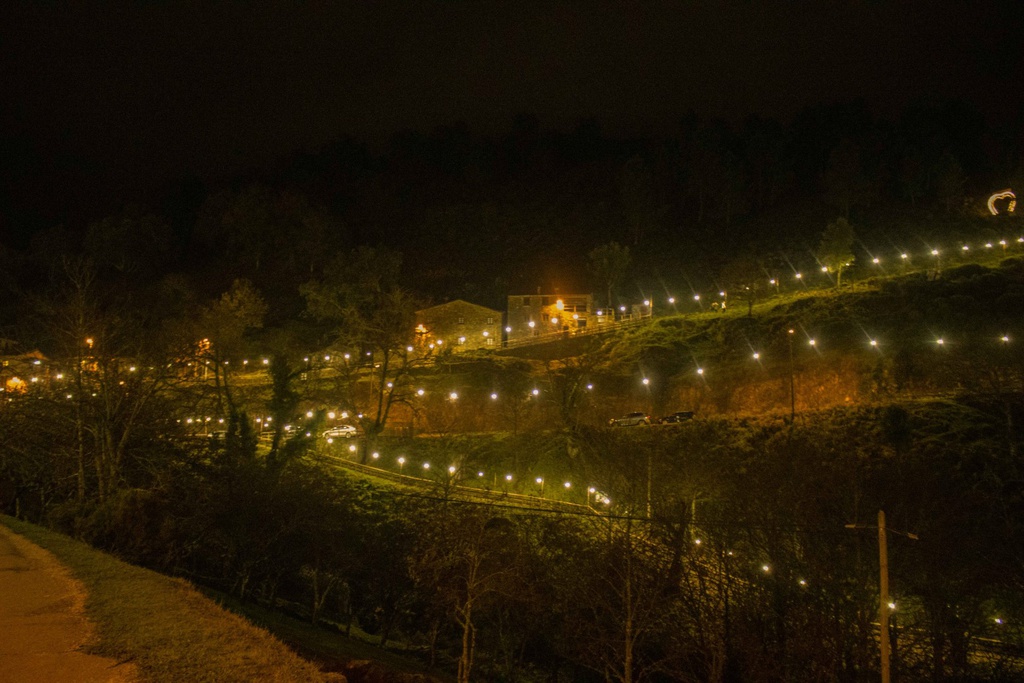This project, composed of an observation point and a pedagogical kiosk, will also feature an event calendar with observation sessions "Starlight Journey”, astrophotography, and guided tours. The observation point, situated at the top of the village, is a semi-spherical steel dome, 7.5 meters high and 15 meters in diameter. It is inspired by an original idea from Buckminster Fuller, reinterpreted by designer João Nunes and designed by architect José Leite. Perfectly integrated into the Natura 2000 Network and the Protected Landscape of Serra do Açor, it subtly stands out as a landmark in the surrounding nature. It serves as a tourist attraction and a privileged location to highlight the relationship between the sky and the earth. Thus begins a new chapter in the territory of Aldeias do Xisto – Starlight Tourist Destination, a new initiative focused on enjoying and protecting the dark sky.
The Geoscope is a multidisciplinary project, a convergence point that unites tourism, science, pedagogy, and territorial development. It promotes immersion in the journey of knowledge and challenges us to reflect on our place in the cosmos and on the planet. Emphasizing astronomical tourism, integrating the educational and scientific community, preserving the night sky, nature and the location, as well as situating humans in an ecological and sustainable perspective, are the main purposes of this project.
The structure consists of a Dome, a place for observation and sensory knowledge, and a Kiosk, a reception and welcoming space located in the village center, integrating theoretical and practical content, with models and virtual reality. The project also benefits from the scientific guidance of astronomer José Matos.
"The dream allows us to dare and transform apparent weaknesses into resources. The darkness, resulting from the absence of large urban clusters, often associated with limitations, now serves as a compass for a new strategic positioning of this territory." This is how the president of ADXTUR summarizes the work that has been developed within the scope of Aldeias do Xisto – Starlight Tourist Destination, now materialized in the Fajão Geoscope. "This is a project that strengthens strategic connections, generates economic and social opportunities, develops exclusive touristic products, safeguards heritage, and promotes the quality of life for the population," explains Paulo Fernandes.
For the mayor of Pampilhosa da Serra, the Fajão Geoscope is another "step forward" in the path that the Municipality has been following in recognizing the excellence of the night sky as a strategic development asset. Jorge Custódio emphasizes that "the unique characteristics and privileged location of the Aldeia do Xisto de Fajão make it an excellent observation point, where an incredible spectacle can be witnessed throughout the year." By investing in the starry sky, the Municipality aims to "position itself as a destination for all those interested in the cosmos and the relationship between the earth and the sky, whether amateurs or professionals."
Aldeias do Xisto – Starlight
The installation of the Geoscope – Astronomical Observatory of Fajão deepens what is already the central value proposition of the Aldeias do Xisto project: immersion and contact with nature, this time under the celestial dome, and with local communities. The project focuses on enjoying the dark sky, stimulating new tourist flows and developing new products, raising awareness for landscape and dark sky protection, and reducing light pollution.
The excellent conditions of visibility, transparency, and darkness of the sky, as well as the readiness and quality of tourist services, earned Aldeias do Xisto the Starlight Tourist Destination Certification, awarded by the Starlight Foundation in 2019 and renewed in 2024.
The Geoscope – Astronomical Observatory of Fajão is a project led by ADXTUR – Agency for the Tourist Development of Aldeias do Xisto, in co-promotion with the Municipality of Pampilhosa da Serra. It is a cornerstone of the Aldeias do Xisto – Starlight Tourist Destination strategy, developed in partnership with 20 municipalities of Pinhal Interior, the Intermunicipal Communities of the Coimbra Region, Leiria Region, Beira Baixa, and Beiras and Serra da Estrela, the Ministry of National Defense, the Telecommunications Institute, the University of Coimbra, and the Faculty of Sciences of the University of Porto.











